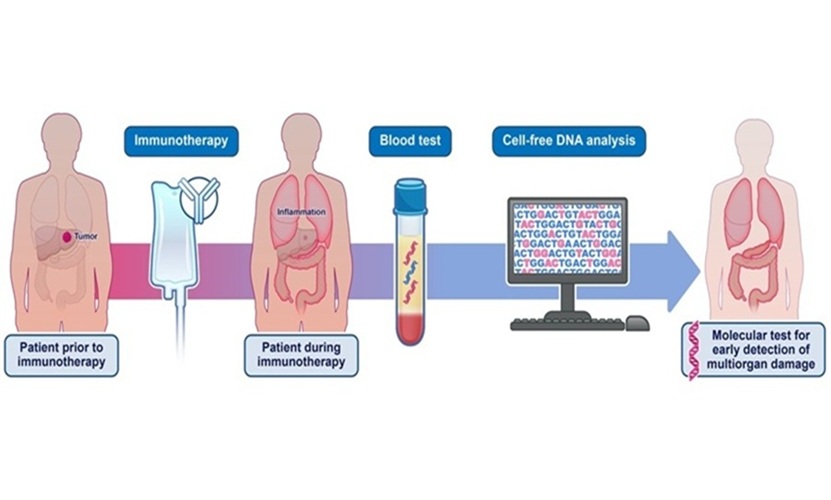Global HBA1c Laboratory Tests Market Driven by Rise in Diabetic Population
|
By LabMedica International staff writers Posted on 03 Dec 2021 |

The global HBA1c laboratory tests market is projected to expand at a significant pace over the coming years, driven by an increase in the prevalence of diabetes, rise in prescription rate of HBA1c tests by physicians, low price of tests, and awareness about complications of high diabetes levels.
These are the latest findings of Transparency Market Research (Albany, NY, USA), a next-generation market intelligence provider.
The term HbA1c corresponds to glycated hemoglobin. HbA1c progresses when a protein hemoglobin present in red blood cells that transports oxygen throughout body joins with blood glucose, thereby becoming 'glycated’. This test is conducted on people with Type 1 and Type 2 diabetes. The normal range for HBA1c is less than 6%. They are also known as glycosylated or glycated hemoglobin. The measurement of HbA1c helps physicians to obtain a lucid picture of average blood sugar levels prevalent for a period of weeks/months
According to World Health Organization and International Diabetes Federation statistics, around 422 million people were suffering from diabetes in 2014. The global prevalence of diabetes has increased from 4.7% in 1980 to 8.5% in 2014. The global HBA1c laboratory tests market is expected to be driven by rise in diabetic population, increase in number of HBA1c laboratory tests, and technological advancements.
Additionally, a large number of employers across the world have introduced wellness programs, which ensure routine medical tests for employees in order to maintain overall productivity and resource efficiency. These initiatives, wherein an employee’s diagnostic tests and sometimes, even treatments are sponsored, have significantly increased the testing volume of clinical laboratories, thereby driving the market’s revenue. Moreover, such wellness programs play an important role in restoring the overall productivity in case of infectious diseases, which tend to affect a large number of people simultaneously.
North America is projected to account for a prominent share of the global HBA1c laboratory tests market over the coming years, led by an increase in awareness about these tests, high rate of adoption of HbA1c tests, owing to increased physicians prescriptions, and technological advancements in the US. Favorable reimbursement policies, increase in the number of laboratories for hemoglobin A1c testing, growth of diabetes among the geriatric population, and rise in funding by governments are anticipated to propel the growth of the North American HBA1c laboratory tests market. An increase in the number of patients with diabetes visiting hospitals and clinics and focus of new players on partnerships with laboratories will drive the US HBA1c laboratory tests market.
Related Links:
Transparency Market Research
Latest Industry News
- BD and Penn Institute Collaborate to Advance Immunotherapy through Flow Cytometry
- Abbott Acquires Cancer-Screening Company Exact Sciences
- Roche and Freenome Collaborate to Develop Cancer Screening Tests
- Co-Diagnostics Forms New Business Unit to Develop AI-Powered Diagnostics
- Qiagen Acquires Single-Cell Omics Firm Parse Biosciences
- Puritan Medical Products Showcasing Innovation at AMP2025 in Boston
- Advanced Instruments Merged Under Nova Biomedical Name
- Bio-Rad and Biodesix Partner to Develop Droplet Digital PCR High Complexity Assays
- Hologic to be Acquired by Blackstone and TPG
- Bio-Techne and Oxford Nanopore to Accelerate Development of Genetics Portfolio
- Terumo BCT and Hemex Health Collaborate to Improve Access to Testing for Hemoglobin Disorders
- Revvity and Sanofi Collaborate on Program to Revolutionize Early Detection of Type 1 Diabetes
- GSI Group Acquires Blood Processing Equipment Manufacturer GenesisBPS
- ELITech and Hitachi High-Tech to Develop Automated PCR Testing System for Infectious Diseases
- Lumiquick Acquires Aoxre to Expand Global IVD and Research Capabilities
- Lunit and Agilent Partner to Develop AI-Powered Cancer Diagnostics
Channels
Clinical Chemistry
view channel
Online Tool Detects Drug Exposure Directly from Patient Samples
Doctors often rely on patient interviews and medical records to determine what medications a person has taken, but this information is frequently incomplete. People may forget drugs they used, take over-the-counter... Read more
Chemical Imaging Probe Could Track and Treat Prostate Cancer
Prostate cancer remains a leading cause of illness and death among men, with many patients eventually developing resistance to standard hormone-blocking therapies. These drugs often lose effectiveness... Read moreMolecular Diagnostics
view channel
CLIA Test Identifies Head and Neck Cancer Recurrence from Post-Surgical Lymphatic Fluid
While the lymphatic system’s critical role in metastasis has long been recognized, routine access to patient lymph has been elusive. Now, a non-invasive process can access lymph through the collection... Read more
New 15-Minute Hepatitis C Test Paves Way for Same-Day Treatment
Chronic hepatitis C infection affects an estimated 50 million people worldwide and causes around 242,000 deaths each year, largely due to cirrhosis and liver cancer. Although the infection is curable with... Read moreHematology
view channel
MRD Tests Could Predict Survival in Leukemia Patients
Acute myeloid leukemia is an aggressive blood cancer that disrupts normal blood cell production and often relapses even after intensive treatment. Clinicians currently lack early, reliable markers to predict... Read more
Platelet Activity Blood Test in Middle Age Could Identify Early Alzheimer’s Risk
Early detection of Alzheimer’s disease remains one of the biggest unmet needs in neurology, particularly because the biological changes underlying the disorder begin decades before memory symptoms appear.... Read more
Microvesicles Measurement Could Detect Vascular Injury in Sickle Cell Disease Patients
Assessing disease severity in sickle cell disease (SCD) remains challenging, especially when trying to predict hemolysis, vascular injury, and risk of complications such as vaso-occlusive crises.... Read more
ADLM’s New Coagulation Testing Guidance to Improve Care for Patients on Blood Thinners
Direct oral anticoagulants (DOACs) are one of the most common types of blood thinners. Patients take them to prevent a host of complications that could arise from blood clotting, including stroke, deep... Read moreImmunology
view channel
Blood Test Could Detect Adverse Immunotherapy Effects
Immune checkpoint inhibitors have transformed cancer treatment, but they can also trigger serious immune-related adverse events that damage healthy organs and may become life-threatening if not detected early.... Read more
Routine Blood Test Can Predict Who Benefits Most from CAR T-Cell Therapy
CAR T-cell therapy has transformed treatment for patients with relapsed or treatment-resistant non-Hodgkin lymphoma, but many patients eventually relapse despite an initial response. Clinicians currently... Read moreMicrobiology
view channel
Blood-Based Diagnostic Method Could Identify Pediatric LRTIs
Lower-respiratory tract infections (LRTIs) are a leading cause of illness and death worldwide, and pneumonia is the leading infectious cause of death in children under five, claiming the lives of over... Read more
Rapid Diagnostic Test Matches Gold Standard for Sepsis Detection
Sepsis kills 11 million people worldwide every year and generates massive healthcare costs. In the USA and Europe alone, sepsis accounts for USD 100 billion in annual hospitalization expenses.... Read moreRapid POC Tuberculosis Test Provides Results Within 15 Minutes
Tuberculosis remains one of the world’s deadliest infectious diseases, and reducing new cases depends on identifying individuals with latent infection before it progresses. Current diagnostic tools often... Read more
Rapid Assay Identifies Bloodstream Infection Pathogens Directly from Patient Samples
Bloodstream infections in sepsis progress quickly and demand rapid, precise diagnosis. Current blood-culture methods often take one to five days to identify the pathogen, leaving clinicians to treat blindly... Read morePathology
view channel
Rapid Low-Cost Tests Can Prevent Child Deaths from Contaminated Medicinal Syrups
Medicinal syrups contaminated with toxic chemicals have caused the deaths of hundreds of children worldwide, exposing a critical gap in how these products are tested before reaching patients.... Read more
Tumor Signals in Saliva and Blood Enable Non-Invasive Monitoring of Head and Neck Cancer
Head and neck cancers are among the most aggressive malignancies worldwide, with nearly 900,000 new cases diagnosed each year. Monitoring these cancers for recurrence or relapse typically relies on tissue... Read more
Common Health Issues Can Influence New Blood Tests for Alzheimer’s Disease
Blood-based tests for Alzheimer’s disease are transforming diagnosis by offering a simpler alternative to spinal taps and brain imaging. However, many people evaluated at memory clinics also live with... Read more
Blood Test Formula Identifies Chronic Liver Disease Patients with Higher Cancer Risk
Chronic liver disease affects millions worldwide and can progress silently to hepatocellular carcinoma (HCC), one of the deadliest cancers globally. While surveillance guidelines exist for patients with... Read moreTechnology
view channel
Machine Learning Models Diagnose ALS Earlier Through Blood Biomarkers
Amyotrophic lateral sclerosis (ALS) is a rapidly progressive neurodegenerative disease that is notoriously difficult to diagnose in its early stages. Early symptoms often overlap with other neurological... Read more



















